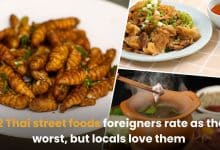Is kaeng som the worst dish in Thailand?
Taste Atlas sets out to offend everyone and succeeds, again

Is an innocent soup, kaeng som, really the worst dish in Thailand?
Thai foodies have, once again, taken the bait set for them by another bizarre “Best of” listicle generated by the unsupervised children working at Taste Atlas.
This week’s deliberately insulting clickbait is a listicle called 100 Worst-Rated Dishes in the World, and the chosen dish of despair for Thailand is kaeng som.
Kaeng som – sour curry – is the chicken soup of Thailand. It doesn’t have a recipe as such, it’s just something that everyone knows how to make. Kaeng som popular everywhere and hundreds of variations exist. Your grandmother gives it to you when you are sick.
It’s not exactly haute cuisine and your Thai grandmother’s kaeng som – the worst dish in Thailand – will taste nothing like my grandmother’s. In fact, a fully accurate description of kaeng som would simply be “sour Thai curry without coconut milk,” and that includes an awful lot of recipes.
At its core, it is just chilli paste simmered in stock or water with fish or shrimp and vegetables. Because there’s no coconut milk, it’s pretty spicy. But spiciness does not make a dish “bad” regardless of how many people dislike it. Criticising Thai food for being spicy is a bit like criticising Mexican food for having too many beans. It does not make sense.
The sourness comes from a variety of possible sources and while tamarind or lime are the most popular (certainly in Western-style Thai restaurants overseas), Thailand has no shortage of sour fruits. To any Thai person, the idea of preparing kaeng som from a recipe is absurd.
The problem with this list is that the list makers don’t seem to know what “bad” means. They think that a funny name makes food bad; a funny picture makes food bad; traditional jokes between grandparents (“smells like feet”) and grandkids make food bad. It’s that kind of joke which are probably the main reasons these dishes are included in the list. This is clickbait, this is not culinary advice, not by any stretch of the palate.
Kaeng som was ranked 12th in the 100 Worst Dishes. Items on the list are suspiciously geographically widespread and the categories of food compared – from confectionary to fermented tofu – encompass a wide range of food courses. It is almost as if the people making up the list had used other criteria in their selection than the simple quality of the food. It’s almost as if the authors were making a listicle!
The dish is described quite fairly, by Taste Atlas as a “sour, water-based Thai curry that is typically prepared with fish or shrimps and a thick paste that usually incorporates shallots, chillies, and shrimp. “The dish scored 2.3/5, though we know nothing about the scoring system, nor the judges, nor even the name of the intern who made up this list.
The main criterion seems to be “what Thai dish should we put on the list to upset Thai people?”
And how high up the list? Well… how ridiculously hypersensitive to national shame are Thai people? Answer, very, very high!
And are Thai people furious? Of course, they are! Many say kaeng som (the worst dish in Thailand) is a household dish as popular as tom yum kung and pad Thai (which it isn’t).
Tastebuds from other countries were also confused by the list. They don’t know clickbait from a foie gras butty.
Some – who presumably get all their nutrition from blenders – said the food should not be judged by its look, which makes no sense at all since the appearance of food is the highest level of culinary skill and the defining factor in how food tastes.
Many rejected the ranking outright as nonsense. One user said the list must have been artificially intelligent-generated, (but with a lot of A’s and very few I’s).
Previously, TasteAtlas succeeded in making a name for itself all over the world with the offensive TasteAtlas Awards 2022 list of “Best Cuisines in the World” in which the United States was placed ahead of Thailand. Again, the list made no sense at all at any level. The so-called “cuisines” were just more or less randomly arranged on the list.
The list was a success, not because it gave an accurate and thoughtful opinion, but because people got upset about it, talked about it, commented, clicked and reproduced the story on their news site.
We’re doing that again today because no matter what the quality of the food, you will (and already did) click.
Latest Thailand News
Follow The Thaiger on Google News:


























